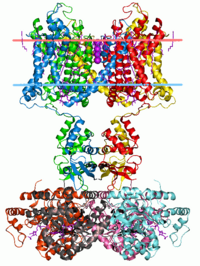
Photo from wikipedia
Heterotetramer voltage-gated K+ (KV) channels KV2.1/KV6.4 display a gating charge-voltage (QV) distribution composed by two separate components. We use state dependent chemical accessibility to cysteines substituted in either KV2.1 or… Click to show full abstract
Heterotetramer voltage-gated K+ (KV) channels KV2.1/KV6.4 display a gating charge-voltage (QV) distribution composed by two separate components. We use state dependent chemical accessibility to cysteines substituted in either KV2.1 or KV6.4 to assess the voltage sensor movements of each subunit. By comparing the voltage dependences of chemical modification and gating charge displacement, here we show that each gating charge component corresponds to a specific subunit forming the heterotetramer. The voltage sensors from KV6.4 subunits move at more negative potentials than the voltage sensors belonging to KV2.1 subunits. These results indicate that the voltage sensors from the tetrameric channels move independently. In addition, our data shows that 75% of the total charge is attributed to KV2.1, while 25% to KV6.4. Thus, the most parsimonious model for KV2.1/KV6.4 channels’ stoichiometry is 3:1.
Journal Title: Scientific Reports
Year Published: 2017
Link to full text (if available)
Share on Social Media: Sign Up to like & get
recommendations!